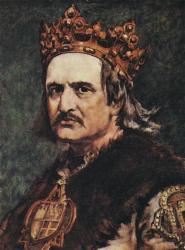
Born: c.1350
Died: June 1,1434, Grodek, Poland
Early days.
Father Algirdas (Olgierd) Grand Duke of Lithuania whose sister Aldona was married to the Polish king Casimir the Great (Kazimierz Wielki); mother ???
First and second marriages and crowning.King Louis of Poland (Louis of Anjou, Ludwik Wegierski) and Hungary had died in 1382, leaving behind two daughters. The Polish nobility had the younger daughter, Jadwiga, break with her fiance Wilhelm von Habsburg; they offered her in marriage to Duke Jogaila (widely known under the Polish spelling of his name, Jagiello) of the Grand Duchy of Lithuania, if the pagan Lithuanians would convert to Catholicism and if the Grand Duchy of Lithuania would agree to give Podolia (Podole) to Poland. Jadwiga accepted Jagiello, and the union of rulers and countries were set forth in the Treaty of Krewo. The queen used the signing of the treaty (on August 23, 1385) as an excuse to have all the prisoners in Cracow released as a sign of her joy.
Jagiello fulfilled both conditions. Jagiello became king of Poland as Ladislaus II (Polish Władysław II) in 1386 after converting to Christianity on February 15 and marrying Jadwiga, second of Poland's Angevin rulers (the first one was Louis of Anjou) ; the marriage was held on February 18,1386. Jagiello first co-ruled with Jadwiga until her death in 1399. Few years after Jadwiga’s death he married Anna of Cilli (Ona)- also a descendant of the Piast dynasty. She died soon.
Christianization of Lithuania.As soon as winter fell in 1386, Jagiello set out for Lithuania to begin Christianization. He removed the outward symbols of the pagan religion- dousing the sacred flame at Vilnius, felling the sacred groves, and disposing of the serpents that traditionally lived in the temples and under house doorsteps. In April 1388 the Pope, Urban IV, issued a bull granting Wladyslaw Jagiello the elevated title of 'rex christianissimus'.
Jagiellonian University.In the year 1400, Jagiello reestablished the inactive Cracovian Academy by renewing its deed of foundation. It was Jadwiga who left her entire personal fortune for the refounding of the University. To this day the university bears his name "Uniwersytet Jagiellonski”.
Jagiello’s accession marked the start of the Jagiellonian dynasty, which was to rule both countries until 1572, presiding over their administrative union in 1569. The Jagiellonian era is usually characterized as the start of Poland's "golden age", when the country became a major European power and extended its frontiers to the north and east.
Teutonic Knights.Grunwald. The Teutonic Knights were a Crusading Order who had been invited into Poland and Prussia by Konrad of Mazovia in 1217 to oppose the raids of the pagan Prus. A crusading, not a missionary order, the Knights killed or enslaved (rather than converting) the heathens, and moved into their territory. After exterminating the Prus, they advanced on Lithuania. Many of the nobles of Europe had fought with the Order on occasion (Norman Davies called these "crusading package tours"), including Louis of Anjou, and they were considered to be notable allies- or foes.
The attacks of the Order devastated both Lithuania and Poland. Jagiello’s cousin Vytautas (Witold), Grand Duke of Lithuania and Jagiello secretly began organizing for war. Weapons were produced, food supplies were stocked and all necessary arrangements were made.
In the summer of 1410 near Plock, Wladyslaw-Jagiello and his Chief-of-Staff Zyndram z Maszkowic crossed Vistula near Czerwinsk on the bridge of pontoons secretly prepared. On July 15th at Grunwald (about 20 miles SW of Olsztyn), the largest battle ever to occur in Europe during the Middle Ages was fought. 39,000 strong army composed of Poles (including a contingent of Polish knights under Zawisza Czarny z Garbowa), Lithuanians (under Vytautas), Czechs (under Zizka), Samogitians, Ruthenians, Tartars , and Wallachians fought against 27,000 Teutonic Order knights including many foreign guests. By the end of the battle almost half of the Teutonic Knights were killed. The Order's Grand Master Ulrich von Jungingen was dead. 14,000 prisoners were taken for ransom. The king Jagiello himself wqas saved from the lance of a Teutonic knight by Zbigniew Olesnicki who became a bishop in 1423 and cardinal in 1439 (after Jagiello’s death).
Treaty of Torun.Agreement of Horodlo.The treaty of Torun was signed on February 1, 1411. In it the existing frontiers were confirmed, free trade on the Vistula assured . The Order made a conditional retreat from Samogitia. But to this day, scholars are left pondering why the victory was not used to its full advantage. Why was the Order allowed to recover? An additional agreement between Poland and Lithuania was signed on October 2, 1413 in Horodlo. Here, in effect, the Polish lords and Lithuanian boyars formed themselves into a joint estate. The Grand Duchy, although closely allied with Poland, remained a separate political entity. The Grand Duchy included Lithuanian (now Catholic) heartland in the north, and large stretches of areas inhabited by Ruthenians (Belarusians, Ukrainians) of Orthodox confession.
Sources:
Davies, Norman. God's Playground: a history of Poland. Volume I. (NY: Columbia Univ. Press, 1982) ISBN: 0-231-053531-7.
Lituanus
Pliszka(in Polish)
Belarus (in Belarussian and in English)
Return to home page:
Prominent Poles